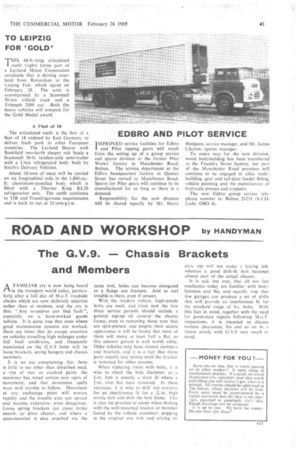ROAD AND WORKSHOP by HANDYMAN
Page 45

If you've noticed an error in this article please click here to report it so we can fix it.
The G.V.9. — Chassis Brackets and Members
A FAMILIAR cry is now being heard
in the transport world today, particularly after a full day of M.o.T. roadside checks which are now definitely selective rather than at random, and the cry is this: "Any so-and-so can find fault ", especially on a bard-worked goods vehicle. It is quite true that even where good maintenance systems are worked, there are items that do escape attention on vehicles travelling high mileages-under full load conditions, and frequently mentioned on the G.V.9 form will be loose brackets, spring hangers and chassis members.
It is no use complaining that there is little to see other than disturbed mud, a rim of rust or cracked paint; the examiner has noted certain sure signs of movement, and that movement spells wear with trouble to follow. Movement at any anchorage point will worsen rapidly and the trouble area can spread and become expensive —even dangerous. Loose spring brackets can cause brake snatch, or drive chatter, and where a cross-member is also attached via the same bolt, holes can become elongated or a flange can fracture. And so real trouble is there, even if unseen.
With the modern vehicle, high-tensile bolts are used, and from new the first three service periods should include a general nip-up all around • the chassis frame, even to removing those nuts that are split-pinned; and despite their secure appearance it will be found that most of them will move at least half a flat, so this amount gained is well worth while. Older vehicles may have riveted members and brackets, and it is a fact that those parts usually stay secure until the bracket is removed for other reasons.
When replacing rivets with bolts, it is wise to check the hole diameter, as a +-in bolt is usually a slack fit where a {-in. rivet has been removed. In these instances, it is wise to drill out oversize for an interference tit for a high tensile bolt and drift the bolt home. Ibis is also the practice to adopt when dealing with the well-loosened bracket or member found by the vehicle examiner; popping in the original size bolt and relying on pure nip will not make a lasting job. whereas a good drift-fit bolt becomes almost part of the actual chassis.
It is sad, but true, that all too few mechanics today are familiar with interferences and fits, and equally true that few garages can produce a set of drills that will provide an interference fit for the standard range of h.t. bolts. With this fact in mind, together with the need for good-class repairs following M.o.T. inspections, it is intended to discuss various clearances, fits and so on in a future article with G.V.9 very much in mind.




















































































































